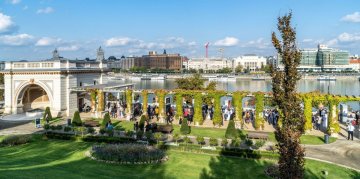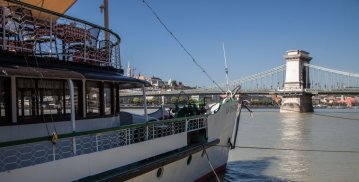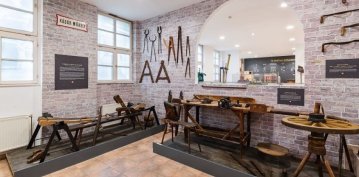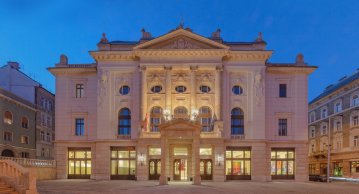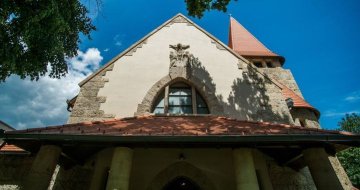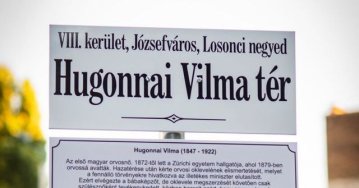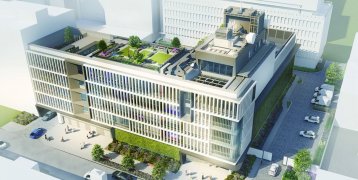 The „intertwined history” of the bridges and the city of Budapest
Which ideas and events have shaped the fate of bridges of Budapest and the cityscape? Alongside many other interesting facts, this question is also answered this newly published book by the Budapest City Archives, which introduces the history of bridges in Budapest.
The „intertwined history” of the bridges and the city of Budapest
Which ideas and events have shaped the fate of bridges of Budapest and the cityscape? Alongside many other interesting facts, this question is also answered this newly published book by the Budapest City Archives, which introduces the history of bridges in Budapest.
Search result
Government to create 3000 P+R parking spaces to reduce traffic in Budapest
October 12, 2020 at 7:30 PM
A government decree recently published in the official Hungarian Gazette allows planning of over three thousand P+R parking spaces and storage for at least two thousand B+R bicycles to begin this year. The hope is that the improved facilities will encourage people living in the Budapest agglomeration to travel into the city centre by train or suburban railway and contribute to a reduction in traffic.
Parliament or Palace? – Construction of the Hungarian parliament began 135 years ago
October 12, 2020 at 5:58 PM
On 12 October 1885 150 workers began to dig a 40,000-cubic-metre pit. With this construction of the Hungarian parliament building began based on plans drawn by Imre Steindl. Lasting nearly two-decades the project transformed a neglected, to-be-developed part of the city, Tömő tér, into one of the most symbolic places in the country.
Liveable Budapest? The first plans were made 80 years ago
October 11, 2020 at 1:00 PM
Budapest adopted its first modern urban development plan in 1940. The massive 150-page document took eight years to prepare. Its main goal was to provide a livable environment for the inhabitants of the quickly growing city. The plan accounted for an increase in motor traffic, marked routes for underground railways, and pushed for architecturally unified residential areas. It also contained plans for the creation of community gardens in the densely populated areas of Pest and designated the embankment as an expressway for vehicles.
Livable Budapest? The first plans were made 80 years ago
October 11, 2020 at 1:00 PM
Budapest adopted its first modern urban development plan in 1940. The massive 150-page document took eight years to prepare. Its main goal was to provide a livable environment for the inhabitants of the quickly growing city. The plan accounted for an increase in motor traffic, marked routes for underground railways, and pushed for architecturally unified residential areas. It also contained plans for the creation of community gardens in the densely populated areas of Pest and designated the embankment as an expressway for vehicles.
A place of beauty in the heart of the city – 225 years of Bakáts Square
October 10, 2020 at 12:00 PM
There are few places in modern Budapest where the defining institutions of community life can be found side by side. There may not even be such a place any more. Nevertheless, one-hundred or one-hundred and fifty years ago people believed it was vital that they not have to cover large distances to go to church, drop their Children of at school, reach a hospital quickly or sort official matters out. It was best, if church, school, hospital, administrative offices or maybe even a cinema or social club could be found nearby. Bakáts Square was just such a place.
Zugló turns 85 – A district of palaces, villas and housing estates
October 9, 2020 at 3:00 PM
Established ninety years ago, Zugló became an independent district 85 years ago. The 14th District connects the city centre with the outer parts of the city, and its role is reflected in its architecture. Beautiful villas built by artists stand alongside stunning school buildings, monuments and the headquarters of various institutions in the styles of historicism and Art Nouveau and these were joined in the 1970s by housing estates.
Founded 70 years ago the KFKI served as a meeting place for Nobel laureates
October 8, 2020 at 2:00 PM
The Central Physics Research Institute, KFKI was established in Csillebérc seventy years ago. Near Normafa the institution quickly became a central location of scientific and academic life in Hungary and was visited by several Nobel Prize-winning researchers. The first nuclear reactor in Hungary, which is still operational, was built here, and the Pille radiation dose meter was also developed on the campus. Scientists awarded by NASA have also worked within its walls. Divided into several divisions after the end of socialism in Hungary, Csillebérc still houses committed researchers.
A bridge without a name – How Chainbridge in Budapest had no name
October 7, 2020 at 11:00 AM
Chain Bridge in Budapest had no official name until 1915 and is still known simply as Chain Bridge in everyday use. However, Lajos Kossuth proposed in 1842 at the laying of its foundation stone that the bridge be named after his great political rival, István Széchenyi, the aristocrat who initiated the construction. Others hoped to name the first permanent crossing between Buda and Pest after princes and princesses. Still, the Ministry of Finance that owned the bridge accepted none of these recommendations. Finally, Széchenyi's name was carved into the structure in 1915, when it was fully rebuilt during the First World War.
Master bell founder Laszlo Szlezák born 150 years ago
October 6, 2020 at 3:00 PM
László Szlezák is possibly one of the best-known Hungarian bell-founders. He came to Budapest at the age of 14 and cast beautiful bells for churches throughout the city. Several of them can still be seen, for example in the Reformed Churches in Angyalföld and on Városligeti Avenue, on Ferenciek Square, in the Catholic Church on Haller Street, and the Kőbánya Church designed by Ödön Lechner. His largest and most famous work, the 7945 kg Saint Emeric bell cast for Saint Stephen's Basilica was destroyed in the Second World War.
Volga taxis appeared in Budapest 60 years ago
October 5, 2020 at 10:00 AM
In the 1950s only Főtaxi, owned by the city itself, was allowed to provide taxi services in Budapest. The company had relatively few vehicles in its very diverse fleet. At the beginning of the new decade, they purchased new vehicles from the Soviet Union, which they believed would become the basic taxi in the capital. The Volga M21 was unable to fill this role, and 10 years later, another car took the streets of the capital by storm: the Zhiguli.
Péter Pázmány never visited Budapest – Born 450 years ago the prelate remains a symbol of Hungarian unity
October 4, 2020 at 9:00 AM
When in 1635 Péter Pázmány founded the first University in Hungary – the successor of which operates in Budapest today – Buda and Pest were occupied by the Ottomans. Thus, one of the greatest figures of Hungarian baroque literature, and a leading figure of Hungarian Catholicism, never visited what is today Budapest. Nevertheless, two universities in the capital vie to preserve his memory. Several statues and other works of art depict him around the city, emphasising how the life's work of this Hungarian prelate is unavoidable in public life, education, culture and religion.
How a road to Vienna resulted in a re-evaluation of Budapest
October 3, 2020 at 2:00 PM
The Budapest–Vienna Highway was specifically designed for cars and opened 90 years ago, on 4 October 1930. Public opinion in the country and the capital hoped that the new road would improve Hungary's geopolitical situation and improve tourism. Perhaps not many readers know that drivers would have had to leave the capital through Bécsi Road (Bécs is the Hungarian name for Vienna) in the 3rd District to reach the Austrian capital.
New rail bridge being built between Ferencváros and Lágymányos
October 2, 2020 at 11:00 AM
The bridge being built is the sixth structure to connect the tracks on the two sides of the Danube beside Rákóczi Bridge. However, the current construction is unique, as it is similar to threading a thread through a needle. See the photos of the unique procedure below.
Art Nouveau meets the modern world – The final building planned by Albert Kőrössy Kálmán
October 1, 2020 at 11:00 AM
The renovation of the villa under 26 Benczúr Street was recently completed. The exterior designed by Albert Kálmán Kőrössy has remained an art nouveau villa, while the interior has become a modern space, equipped with state-of-the-art technology. Build as a residential building, it later became a language examination centre, and now houses a centre for education and innovation.
Replanned twice by the great Ybl – Construction of the Main Customs House began 150 years ago
September 30, 2020 at 10:00 AM
The stunning Renaissance revival palace of the Main Customs House by Miklós Ybl is better known today as Corvinus University. The building has defined the view of the Danube embankment since its completion. A lesser-known fact about the building is that it was initially planned for Kossuth Square. Foundation work began but later stopped when Gyula Andrássy (the prime minister in office at the time) supported the Budapest City Council in the dispute about the site. The building was moved to Ferencváros, and Ybl was forced to redraw his plans for the palace twice before construction began 150 years ago.
Statue of Saint Stephen may be erected in Kispest, not Saint Stephen's Park
September 29, 2020 at 5:00 PM
Budapest City Council to vote on the question of where a new statue of Saint Stephen will be erected on 30 September. The statue was originally planned for Saint Stephen's Park in the 13th District, but the proposal is to erect it on Templom Square in the 19th District. The Wallenberg Monument, the monument to Heroic Budapest Partisans, and a statue of Ferenc Fejtő currently stand in the park. The statue of the communist People's Commissioner György Lukács was removed in 2017.
The 250 years of Semmelweis University – Exhibition opens in the Museum of Medical History
September 28, 2020 at 2:00 PM
The Faculty of Medicine of the Nagyszombat University (present-day: Trnava, Slovakia) founded by Péter Pázmány was established on 7 November 1769 by the decree of Queen Maria Theresa. The first academic year began on 8 November 1770. The exhibition entitled from Nagyszombat to Klinikák – Teaching, Tradition and Innovation has been opened to commemorate the 250-year anniversary of this.
Hospital on the outskirts – Huge effort by 19th-century decision-makers improved healthcare
September 28, 2020 at 9:00 AM
The construction of Saint John's Hospital (Szent János Kórház) began 125 years ago, on a hillside where vineyards had once stood. The 300-bed modern hospital was much needed, as the old building of the hospital, on the present-day Széna Square, was gravely overcrowded. Doctors feared that the influx of workers to the capital caused by the construction of projects connected to the upcoming national millennium would lead to catastrophe.
Kőbánya pays its respects to King Saint Ladislaus
September 27, 2020 at 10:00 AM
Before the stunning church planned by Ödön Lechner in Kőbánya stands a statue of King Saint Ladislaus. The district also houses not only a church, but a respected secondary school, a primary school and a square that bare the name of the saint king. As the cult of Saint Ladislaus is uniquely strong in this part of the city, the district was gifted the statue of saint in 1940, when the nation commemorated the 900th anniversary of his birth. The statue by Károly Antal, was erected before the church as the public sculpture of the king to be placed in Budapest.
The baroque splendour of Óbuda – A palace visited by Maria Theresa
September 26, 2020 at 6:00 PM
The Zichy Palace on the main square of Óbuda (Fő tér) once housed a luxurious lifestyle. The building's baroque splendour, ornate gates, large interiors, its ballroom, billiard room and shooting range, alongside its garden with fountains and exotic plants guaranteed both entertainment and rest. Even Queen Maria Theresa visited the famous palace, where concerts and theatrical performances were commonplace, and even the count himself acted. What has remained of the legacy of the Zichy family?
Research into what was once the Pest city wall
September 26, 2020 at 1:00 PM
Archaeologists have carried out excavations in Bástya Street in the pest city centre, where part of Pest's city wall once stood. The dig led to finds from the 13th century to the Ottoman Period, including the remains of houses, kilns and ditches.
House of Hungarian Music wins international prize
September 25, 2020 at 5:00 PM
The House of Hungarian Music has been named the best musical real estate development project in the world at the Music cities Awards in the United States. The building is now structurally complete, and the most spectacular parts of its construction are nearing finalisation.
Legends from Buda Castle: Descendants of Hauszmann and Strobl join opening of new photographic exhibition in the Castle Garden Bazaar
September 25, 2020 at 12:00 PM
The descendants of the Alajos Hauszmann, the Teleki family and Alajos Strobl can be seen in the portraits newly on display on the Southern Panorama Terrace of the Castle Garden Bazaar. The exhibition entitled legends from Buda Castle – open until 15 November – highlights the connections between the Castle and Budapest through the lives of people deeply connected to the Castle District.
Two-hundred years of shipping in Budapest – New exhibition opened on Kossuth Museum Boat
September 24, 2020 at 5:00 PM
A new exhibition entitled Budapest from the Danube – Pictures from 200 years of shipping in Budapest has opened on the Kossuth Museum Boat anchored on Vigadó Square. The exhibition highlights the most interesting moments of the past two-hundred years of shipping and boat travel in Budapest and opens on Wednesday.
95 years of radio broadcasts in Budapest
September 24, 2020 at 11:00 AM
Hungarian radio had a difficult start. In its first years, listening to the radio without a license was a punishable offence, and permission to access the service was even required later. In the autumn of 1925 chaos reigned: the radio tower in Csepel had been completed, and the studio in Budapest was also being built, but many listened to the experimental broadcasts without permission and ended up in court.
Technical acceptance procedure on southern section of M3 metro begins
September 23, 2020 at 5:00 PM
Metro line M3 is planned to reopen to passengers at the end of October, following the acceptance procedures.
The last unpaved road of Budapest will soon disappear
September 23, 2020 at 9:00 AM
The final dirt roads found in Budapest will be paved in the coming months. The government will provide 5 billion HUF towards the asphalt work in the outer districts of the city.
Church on Szabadság tér constructed for refugees from territories lost after Trianon
September 22, 2020 at 2:00 PM
A church can be found under 2 Szabadság Square, on the ground floor of a six-storey residential building. Wedged between two other blocks of flats, those walking along the pavement may not even realise that they had walked by a church. Few know that it was built by Hungarian refugees that moved to Hungary from areas annexed by neighbouring countries after the Treaty of Trianon that ended World War I.
Renovated Dreher Museum of Beer to reopen
September 22, 2020 at 9:00 AM
The completely revitalized Dreher Museum of Beer will reopen tomorrow with one of the largest collections related to beer in the country. The artefacts in the museum showcase the unique history of not only brewing beer, but the Dreher Brewery: technical and manufacturing equipment, mock-ups, flags, posters, photographs, films, and works of fine art. Visitors will be welcomed from 23 September with digital and interactive content, and beer tastings.
Graves from the Ottman-era and medieval walls found on Margit Boulevard
September 21, 2020 at 6:00 PM
A cemetery from the Ottoman-era has been found during excavation under 19–21 Margit Boulevard. Archaeologists are now searching for the walls of the houses of Felhévíz.
Vigadó of Buda and a family house in Hűvösvölgy named Houses of the Year
September 21, 2020 at 1:00 PM
The winners of the House of the Year competition have been announced. The renovation of the Vigadó of Buda won accolades in the public building category, while a family home in Hűvösvölgy one in the house category.
A place of secrets – A visit to the garden of the National Museum
September 20, 2020 at 12:00 PM
The Night of Artefacts was held this week in Budapest, Between 17–19 September. As part of the event, a walk entitled The Secrets of the Museum Garden was led by Béla Debreczeni-Droppán in the garden of the National Museum.
Reflective sculptures placed on Corvin Promenade
September 19, 2020 at 2:00 PM
A group of reflecting sculptures has been erected in the courtyard of an office building on Corvin Promenade as a result of a competition for young artists. The winner was selected from twenty-two entries with the cooperation of the University of Fine Arts.
A Garden for Kings – The oldest trees of Buda Castle each have a story to tell
September 19, 2020 at 10:00 AM
Standing mementoes of the lost glory of royal gardens the old trees of Buda hold something of the Castle's history. The Japanese pagoda trees, fruit-bearing fig-trees, stunning oaks, lindens and planetrees, or mulberry trees from a time when Hungary produced silk, all have stories to tell. But they do need some help...
Old building of the University of Physical Education being demolished
September 18, 2020 at 4:00 PM
The demolition of the university building on Alkotás Street began recently, as the development of the campus enclosed by Alkotás street – Győri Road – Kis János Altábornagy Road continues. The new campus will offer students and educators a proper university environment to work and study in.
Life underground – Significant population of Pest and Buda lived in cellars before the unification of the cities
September 18, 2020 at 10:00 AM
A census was conducted in Hungary in 1870, 150 years ago. It paints a stunning picture of Buda a Pest before the two cities were unified. Barely 200,000 people lived on the Pest side, and nearly 54 thousand on the Buda side. 15-thousand people lived in cellars, and 13,000 shared their rooms with at least ten other people. The census details how many doctors, writers, teachers lived in the cities, as well as how many unmarried or divorced women called the city home. Two centenarians lived in the city that was experiencing a massive development boom. It was a unique time, in which poverty and grandeur coexisted, and when the Renaissance revival homes so loved to this day were built.
The most Hungarian Habsburg moved to Buda 225 years ago
September 17, 2020 at 11:00 AM
Eventually serving as Palatine of Hungary for over 50 years, the young prince being raised in Florence would never have been expected to later be known as the Most Hungarian Habsburg. Palatine Joseph was only 19 when he moved to Budapest with much ceremony 225 years ago. He settled in the country, lived here with his wife and children, died here and was buried in the crypt of the Royal Palace in Buda Castle. His popularity was founded on the attention he paid to the prosperity of Buda and Pest.
Danube, Tisza, Drava, Sava – Beautiful fountain in Budapest city centre to be renovated
September 16, 2020 at 3:00 PM
A beautiful fountain can be found in the centre of Budapest. Designed by Miklós Ybl, it depicts what were once the four largest rivers of Hungary: the Danube, the Tisza, the Drava and the Sava. Originally erected on Kalvin Square in 1883 it was severely damaged in the Second World War. A copy of the fountain and its statues were later erected on Erzsébet Square. Sadly, these were damaged, not by armed conflict but simply passers-by, leading to the foot of the Sava figure being broken off – a fault that will also be repaired with the complete renovation of the fountain.
New headquarters of the Imre Kertész institute completed
September 16, 2020 at 9:00 AM
The renovation of the Art Nouveau palace under 46 Benczúr Street has been completed. The building will serve as the headquarters of the Imre Kertész Institute which manages the literary legacy of the Noble laureate, and János Sziveri, and parts of the legacies of Arthur Koestler, György Petri and János Pilinszky.
Intervention from Ferenc Deák may have allowed the Hangli Kiosk to open on the Danube promenade
September 15, 2020 at 9:00 AM
The Danube Promenade was once lined with several almost legendary buildings. These included the Redoute, the Queen of England Hotel, the Lloyd Palace and the Ritz Hotel. Alongside the grand palaces stood a small building, the Hangli Kiosk. The restaurant was named after its owner, Mark Hangl, an Austrian-born restaurant owner who came to Budapest at a young age, and who was helped by Ferenc Deák himself, in opening the kiosk. The Hangl Kiosk stood in front of the Pest Vigadó from 1870 until it was lost in the end days of the Second World War, alongside so many other beauties.
Renovated Heart of Jesus Church blessed in Városmajor
September 14, 2020 at 5:00 PM
The renovation of the Heart of Jesus Church in Városmajor has been completed. The façade, interior and roof structure were replaced during the reconstruction. Designed by Aladár Árkay, the church served as a hall of worship for ten years and later became a scene of local community life.
Once a miracle of the National Millennium it was covered by graffiti a hundred years later
September 14, 2020 at 9:00 AM
Built under only 20 months, the first of its kind on the continent and tried by the King. The Millennium Underground Railway, commonly known as the kisföldalatti "small underground" may be Budapest's most likeable means of public transport. It most recent major renovation was finished 25 years ago.
Masses flocked to see the Concorde that landed at Ferihegy
September 13, 2020 at 11:00 AM
The Concorde may be the most impressive passenger aircraft ever created. Flying at twice the speed of sound, it could cross the Atlantic in only three hours. These miracles of a machine visited Budapest several times. The first landed at Ferihegy 35 years ago on 14 September 1985.
Several weakened trees to be felled in Budapest
September 12, 2020 at 9:00 AM
Urban trees require constant care. As part of urban tree care in September, several dangerous, ill and weakened trees will be cut down and new saplings planted in their places. Complete tree-lined streets will be renewed in Wekerletelep in Kispest.
New synagogue opened in Buda
September 12, 2020 at 12:00 AM
New synagogue opened at the Alma Street orthodox Jewish Retirement Home in the 12th District
Square named after Vilma Hugonnai in Józsefváros
September 11, 2020 at 4:00 PM
The previously unnamed square that houses the monument to the doctors that died in World war I, in front of the Department of Obstetrics and Gynecology of Semmelweis University, has been named after Vilma Hugonnai, the first female Hungarian doctor.
Building of the communications authority to be expanded on Visegrádi Street
September 11, 2020 at 2:00 PM
The building complex of the National Media and Info-communication Authority is to be expanded with a new multifunctional wing. The five-story building with three floors underground and two above road level will house offices, meeting rooms, a high-capacity data centre and an event hall.
A visit to Budapest’s newest Reformed Church
September 11, 2020 at 9:00 AM
The Reformed Church opened in Soroksár on 5 September is reminiscent of the turreted towers of Churches in Kalotaszeg (Țara Călatei, Romania). While the eighth Reformed Church to be completed in Budapest since the fall of communism in Hungary way bear marks of long-standing traditions on its exterior, its interior is of a more modern inclination.
New building of the Museum of Ethnography reaches final height
September 10, 2020 at 3:00 PM
The new building for the Museum of Ethnography will be structurally complete this autumn and will open its doors to the public in 2022. The building is being constructed as part of the Liget Budapest Project on the site of the former car park on 56-osok Square.
A debate raging since the 19th century: Trams on Budapest bridges
September 10, 2020 at 11:00 AM
The question of running tracks across Margaret Bridge lead to a major debate during its construction, while trams only started running on Rákóczi bridge 20 years after its construction. Original plans for the bridge to be constructed near Galvani Street did not allocate rooms for trams. Nevertheless, it seems certain that guided transportation connections between Buda and Pest will remain for decades to come.
 The „intertwined history” of the bridges and the city of Budapest
Which ideas and events have shaped the fate of bridges of Budapest and the cityscape? Alongside many other interesting facts, this question is also answered this newly published book by the Budapest City Archives, which introduces the history of bridges in Budapest.
The „intertwined history” of the bridges and the city of Budapest
Which ideas and events have shaped the fate of bridges of Budapest and the cityscape? Alongside many other interesting facts, this question is also answered this newly published book by the Budapest City Archives, which introduces the history of bridges in Budapest.
 The Bridge Report, which brought a turning point in the history of Budapest
A travel report that changed the history of Pest and Buda, as well as Hungary. The little book contributed to the change of half a thousand years of legal customs and the implementation of an investment of unprecedented size and technical quality. This book was The Bridge Report [Hídjelentés in Hungarian].
The Bridge Report, which brought a turning point in the history of Budapest
A travel report that changed the history of Pest and Buda, as well as Hungary. The little book contributed to the change of half a thousand years of legal customs and the implementation of an investment of unprecedented size and technical quality. This book was The Bridge Report [Hídjelentés in Hungarian].
 Drama on the university wall - The heroic monument was planned 95 years ago
In the constant hustle and bustle of the Egyetem Square in Pest, the students may not even notice the monument that decorates the short section of wall between the church and the central building of ELTE. However, it commemorates their predecessors, the heroes who fought for their country in World War I, and those who heroically helped them. The first design of the dramatically collapsing soldier was born in 1928, ninety-five years ago.
Drama on the university wall - The heroic monument was planned 95 years ago
In the constant hustle and bustle of the Egyetem Square in Pest, the students may not even notice the monument that decorates the short section of wall between the church and the central building of ELTE. However, it commemorates their predecessors, the heroes who fought for their country in World War I, and those who heroically helped them. The first design of the dramatically collapsing soldier was born in 1928, ninety-five years ago.






















